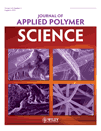Molecular composite of lignin: Miscibility and complex formation of organosolv lignin and its acetates with synthetic polymers containing vinyl pyrrolidone and/or vinyl acetate units
Abstract
Binary blends and pseudo-complexes of organosolv lignin (OSL) or its acetate (OSL-Ac) with synthetic polymers including poly(vinyl acetate) (PVAc), poly(N-vinyl pyrrolidone) (PVP), and poly(N-vinyl pyrrolidone-co-vinyl acetate) (P(VP-co-VAc)) were prepared by casting from mixed polymer solutions in N,N-dimethylformamide as good solvent and by spontaneous coprecipitation from solutions in tetrahydrofuran (THF) as comparatively poor solvent. Thermal analysis by differential scanning calorimetry showed that OSL was not miscible with PVAc; however, OSL(-Ac) was miscible with PVP to form homogeneous blends irrespective of the degree of acetylation of OSL. OSL formed homogeneous blends with P(VP-co-VAc) with ≥30 mol % of VP contents. Fourier transform infrared spectra measurements for the miscible blends of OSL/PVP revealed the presence of hydrogen bonding interactions between hydroxyls of OSL and carbonyls of VP units. However, there was no evidence for the development of the hydrogen bonding in miscible blends of fully acetylated OSL with PVP. For complexes via THF solutions, its formation was found to be primarily due to a higher frequency of hydrogen bonding interactions. © 2012 Wiley Periodicals, Inc. J Appl Polym Sci, 2012




